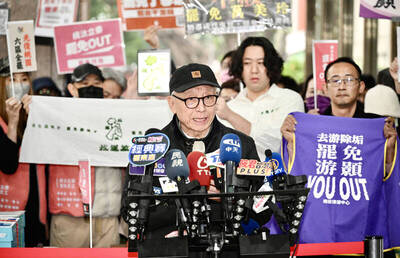When Matt Danzico began seeing cryptocurrency logos in the packaging of grocery store items, he knew he had a problem. Danzico had been swept up in the global craze for trading digital currencies during the pandemic, and very quickly it had grown into an obsession.
“I would have these sleepless nights where I’d be tossing and turning, trying to get these charts out of my head,” said the Barcelona-based designer and visual journalist. “I thought I was losing my mind.”
Cryptocurrencies like bitcoin and ethereum are notorious for their volatility, and the 39-year-old saw “years worth of money won and lost in a very short amount of time.”

Photo: REUTERS
His emotions went on a similar rollercoaster, not helped by the fact that he was speculating in the depths of a COVID-19 lockdown. His wife noticed him becoming anxious and angry.
Danzico declines to specify the damage the experiment did to his finances — suffice to say that “for our bank account, it was bad.”
Reflecting months later during a trip home to the US, the cheerful American mostly feels relieved that he nipped his addiction in the bud fairly quickly.
But as cryptocurrencies have grown from being a niche interest to a more mainstream one, Danzico says experiences much darker than his own are unfolding worldwide.
“We’re talking tens of millions of people who are trading cryptocurrencies,” he said.
“If one small fraction of those people are becoming hooked, we’re talking about a burgeoning potential mental health crisis on a scale that I don’t think that the world has ever seen.”
THE DARKNESS OF CRYPTO TWITTER
Danzico points out that you need look no further than Twitter, where crypto enthusiasts congregate, for a sense of the mental health consequences of the tokens’ chronic instability. Tweets by “people discussing deep depression, really extreme thoughts of isolation and suicide” often accompany plunges in value. In September, a Czech man’s tale of his disastrous attempt to get rich from crypto — taking on spiraling debts as he attempted to claw back his losses — went viral on Twitter.
Depressed and homeless, he was too ashamed to ask for help.
“When I called my mom I just said it’s all ok, I have [a] good job, place to sleep. In reality I was starving,” wrote the user named Jirka, who has since started rebuilding his life.
Disturbed by his own experience and others described online, Danzico began researching crypto addiction, writing up his findings in an article for crypto news site Cointelegraph. He found just one small-scale study into crypto addiction in Turkey, and a few therapists offering professional help, from Thailand to the US.
Experts regard the phenomenon as a form of gambling addiction, noting similarities with Wall Street traders whose investments have spun out of control.
Castle Craig, a Scottish rehab clinic, describes crypto addiction as a “modern day epidemic.” The problem is more common in men, the clinic notes on its Web site, “but this might just be because women trade cryptocurrencies less than men.”
ART AS THERAPY
For Danzico, it’s “alarming” that more specialized help isn’t available. Part of the problem, he suspects, is that people don’t realize quite how mainstream crypto speculation has become. Trading platform Crypto.com estimated in July that 221 million people were now trading worldwide. That figure had more than doubled in six months as millions began dabbling while stuck at home during the pandemic. It was only after Danzico began trading himself that he began noticing signs that fellow traders were everywhere.
A neighbor would whoop every time ethereum spiked; he’d see young men in the street fretting over a crypto chart on a phone screen. Danzico kicked his own habit by pouring his obsession into photography, using a light projector to superimpose images of crypto logos and charts onto the world around him.
Finding a way to express how all-consuming trading had become “somehow allowed me to move past it”, he said.
He is now, with self-confessed irony, selling digital versions of the images as NFTs — non-fungible tokens, for which he is paid in ethereum.
Danzico still has some crypto assets, and believes that decentralized finance has a bright future. But he wants society to face up to what he regards as “an enormous mental health crisis.”
“You have kids who are literally becoming millionaires in their parents’ basements and then losing it all before they run up for dinner,” he said.
“What we can do is begin talking about this.”

The Democratic Progressive Party (DPP), Chinese Nationalist Party (KMT), and the country’s other political groups dare not offend religious groups, says Chen Lih-ming (陳立民), founder of the Taiwan Anti-Religion Alliance (台灣反宗教者聯盟). “It’s the same in other democracies, of course, but because political struggles in Taiwan are extraordinarily fierce, you’ll see candidates visiting several temples each day ahead of elections. That adds impetus to religion here,” says the retired college lecturer. In Japan’s most recent election, the Liberal Democratic Party lost many votes because of its ties to the Unification Church (“the Moonies”). Chen contrasts the progress made by anti-religion movements in

Taiwan doesn’t have a lot of railways, but its network has plenty of history. The government-owned entity that last year became the Taiwan Railway Corp (TRC) has been operating trains since 1891. During the 1895-1945 period of Japanese rule, the colonial government made huge investments in rail infrastructure. The northern port city of Keelung was connected to Kaohsiung in the south. New lines appeared in Pingtung, Yilan and the Hualien-Taitung region. Railway enthusiasts exploring Taiwan will find plenty to amuse themselves. Taipei will soon gain its second rail-themed museum. Elsewhere there’s a number of endearing branch lines and rolling-stock collections, some

Last week the State Department made several small changes to its Web information on Taiwan. First, it removed a statement saying that the US “does not support Taiwan independence.” The current statement now reads: “We oppose any unilateral changes to the status quo from either side. We expect cross-strait differences to be resolved by peaceful means, free from coercion, in a manner acceptable to the people on both sides of the Strait.” In 2022 the administration of Joe Biden also removed that verbiage, but after a month of pressure from the People’s Republic of China (PRC), reinstated it. The American

This was not supposed to be an election year. The local media is billing it as the “2025 great recall era” (2025大罷免時代) or the “2025 great recall wave” (2025大罷免潮), with many now just shortening it to “great recall.” As of this writing the number of campaigns that have submitted the requisite one percent of eligible voters signatures in legislative districts is 51 — 35 targeting Chinese Nationalist Party (KMT) caucus lawmakers and 16 targeting Democratic Progressive Party (DPP) lawmakers. The pan-green side has more as they started earlier. Many recall campaigns are billing themselves as “Winter Bluebirds” after the “Bluebird Action”